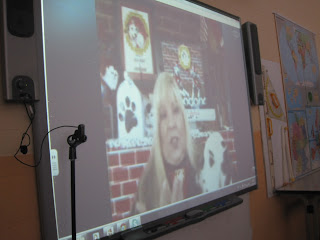Meanwhile I have learned by several Skype meetings that animals can positively influence the educational results of children from the distance. But can these animals influence the behaviour of the children in special situations?
Yesterday we had a Skype meeting with Dayna Hilton from Akransas, USA, and her dog Molly, an eight months' old Dalmatian. Dayna is working as a volunteer fire fighter and member of the"Keep- Kids- Fire-Save- Foundation". This foundation is a federally recognized not- profit charitable organisation dedicated to teaching fire safety knowledge and skills to children and their caregivers based in fire safety research.
And she - and her dog - told our 6th- and 7th graders and their teachers Mrs Sauer and Mr Marx all about fire fighters and why it is important to know what to do in case of emergency. And about dogs who are operating on behalf of fire fighting to find people who are missing. The dog did a lot of funny things to entertain the Germans and its scout.
Half a hour before the official meeting we had had a line check to avoid technical problems during the official meeting.
To reach my students at noon my time Mrs Hilton had to stand up really early in the morning. And Daylight Savings caused an additional problem she solved expertly and with one or two cups of coffee. It was the first educational meeting this organisation had with a school in Germany.
We fixed two video cameras, one at each location of the meeting. The following video takes you into the 40 minutes' meeting for a moment, switching from one point of view to the other:
Thanks, Dayna, for this wonderful meeting!!!





